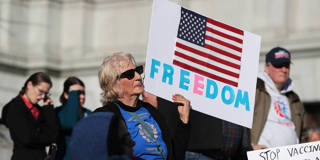JOSEPH E. STIGLITZ

NEW YORK – The Republican Party has long wrapped itself in the American flag, claiming to be the defender of “freedom.” The GOP believes individuals should be free to carry firearms, spew hate speech, and eschew vaccines and face masks. The same goes for corporations: Even if their activities destroy the planet and permanently change the climate, the “free market” should be trusted to sort things out. Banks and other financial institutions should be “liberated” from regulation, even if their activities can bring down the entire economy.
Following the 2008 financial crisis, the pandemic, and the acceleration of the climate crisis, it should be obvious that this conception of freedom is far too crude and simplistic for the modern world. Those who still espouse it are either mind-numbingly blinkered or on the take. As the great twentieth-century philosopher Isaiah Berlin put it: “Freedom for the wolves has often meant death to the sheep.” Or, put another way, freedom for some is unfreedom for others.
In the United States, the freedom to carry guns has come at the expense of the freedom to go to school or the store without being shot. Thousands of innocent people – many of them children – have died so that this particular freedom can live. And millions have lost what Franklin Delano Roosevelt thought was so important, the freedom from fear.
There is no such thing as absolute freedom within a society. Different freedoms must be balanced against each other, and any reasoned discussion among typical Americans (meaning one not captured by political activists and special interests) would inevitably conclude that the right to an AR-15 is not more “sacred” than others’ right to live.
In complex modern societies, there are innumerable ways that one’s actions can harm others without one having to bear any consequences for it. Social-media platforms constantly pollute our “information ecosystem” with disinformation and content that is well-known to cause harm (not least to adolescent girls). While the platforms present themselves as neutral conduits of information that is already out there, their algorithms are actively promoting a socially harmful substance. But, far from paying any costs, the platforms are reaping billions of dollars in profits every year.
The US tech giants are shielded from liability by a 1990s-era law that was originally designed to foster innovation in the inchoate digital economy. The US Supreme Court is now considering a case involving this legislation, and other countries around the world are also questioning whether online platforms should be able to avoid accountability for their actions.
For economists, a natural measure of freedom concerns the range of things one can do. The greater one’s “opportunity set,” the freer one is to act. Someone on the verge of starvation – doing what she must just to survive – effectively has no freedom. Viewed this way, an important dimension of freedom is the ability to realize one’s potential. A society in which large segments of the population lack such opportunities – as is the case in societies with high levels of poverty and inequality – is not really free.
Investments in public goods (such as education, infrastructure, and basic research) can expand the opportunity set for all individuals, effectively enhancing the freedom of all. But such investments require taxes, and many individuals – especially in a society that valorizes greed – would rather free ride, by avoiding paying their fair share.
This is a classic collective-action problem. Only through coercion, forcing everyone to pay their taxes, can we generate the revenue needed to invest in public goods. Fortunately, all individuals, including those who have been forced against their will to contribute to society’s investments, may be better off as a result. They will live in a society where they, their children, and everyone else has a larger opportunity set. In such circumstances, coercion is a source of liberation.
Neoliberal economists have long ignored these points and focused instead on “freeing” the economy of what they view as pesky regulations and taxes on corporations (many of which have benefitted massively from public expenditures). But where would American business be without an educated labor force, the rule of law to enforce contracts, or the roads and ports needed to transport goods?
In their new book, The Big Myth, Naomi Oreskes and Erik M. Conway show how business interests managed to sell the American public on the staunchly anti-government, “free market” vision of capitalism that emerged in the decades after World War II. The rhetoric of “freedom” was key. The captains of industry and their academic servants systematically re-characterized our complex economy – a rich matrix of private, public, cooperative, voluntary, and not-for-profit enterprises – as simply a “free enterprise” economy.
In books like Milton Friedman’s Capitalism and Freedom and Friedrich Hayek’s The Road to Serfdom, capitalism was crudely equated with freedom. Central to this vision of capitalism is the freedom to exploit: Monopolies should have unfettered power to trample potential entrants and squeeze their workers, and firms should be free to collude to exploit their customers. Yet only in a fairy tale world (or an Ayn Rand novel) would such a society and economy be called “free.” Whatever we call it, it is not an economy that we should want; it is not one that promotes broadly shared prosperity; and the greedy, materialistic individuals that it rewards are not who we should want to be.
The Democratic Party needs to reclaim the word “freedom,” as do social democrats and liberals around the world. It is their agenda which is genuinely liberating, which is expanding opportunities, and which is even creating markets that are truly free. Yes, we desperately need free markets, but that means, above all, markets that are free from the stranglehold of monopoly and monopsony, and from the undue power that big businesses have amassed through ideological myth-making.
No comments:
Post a Comment